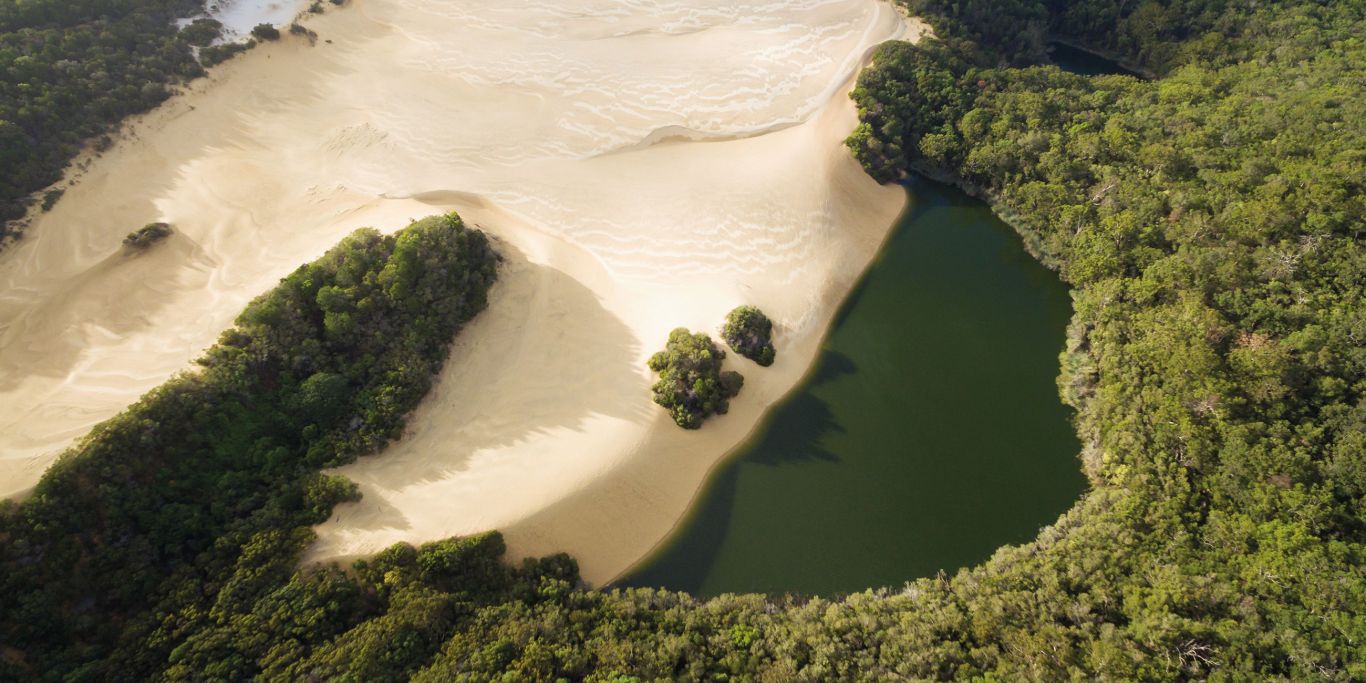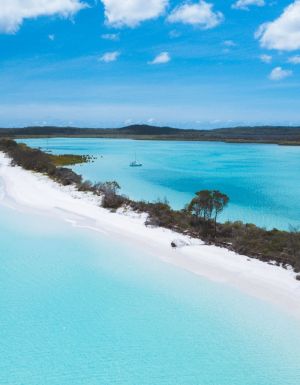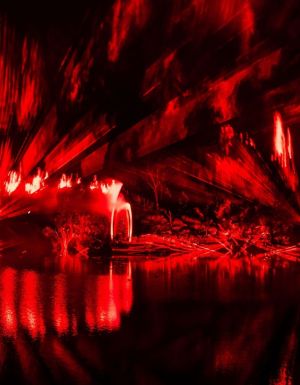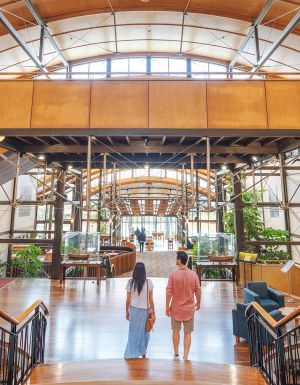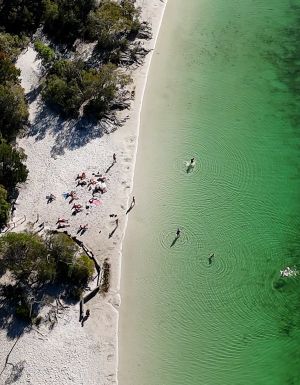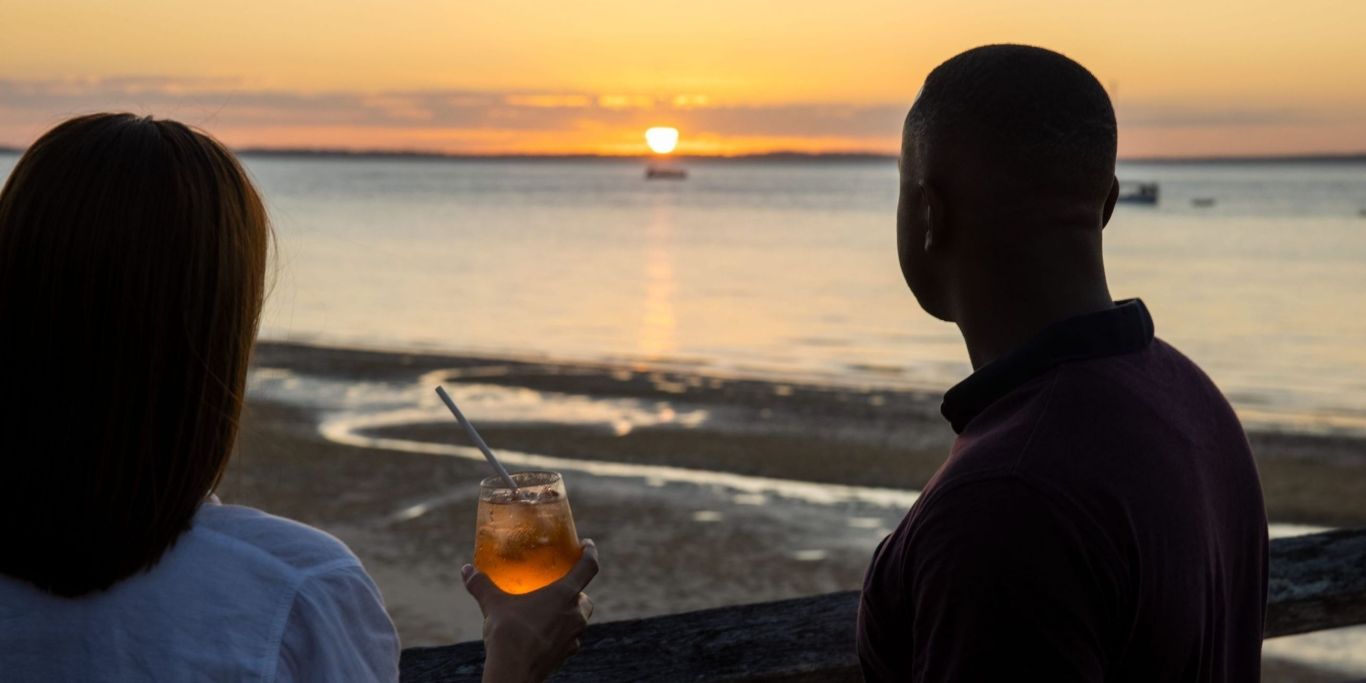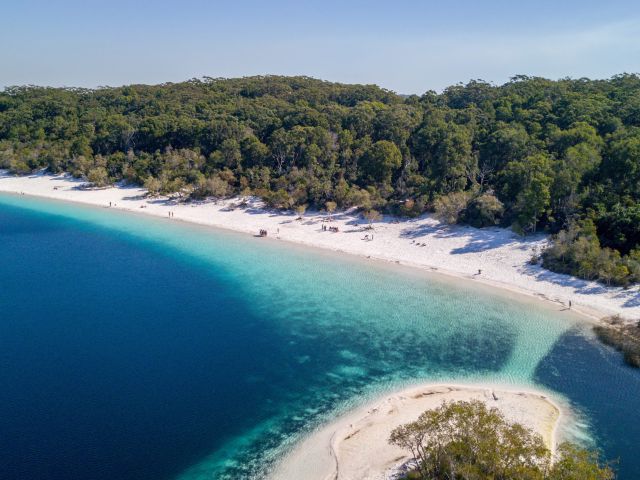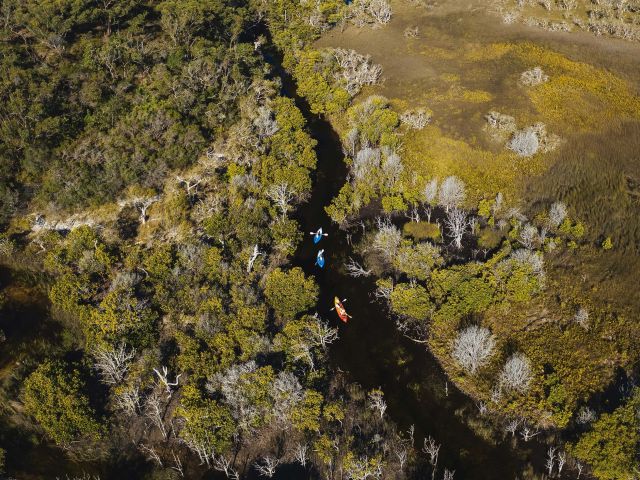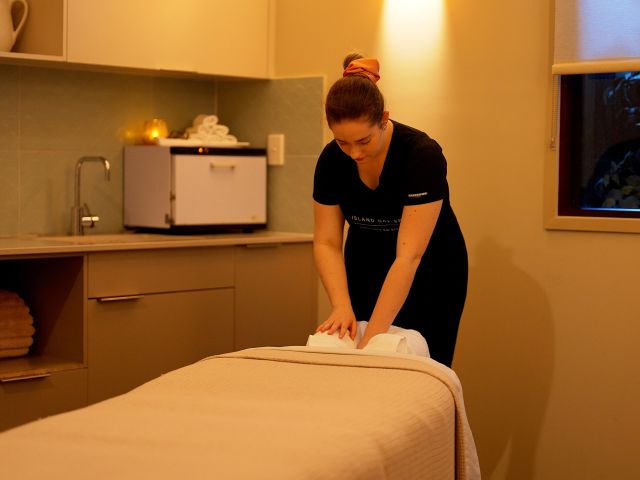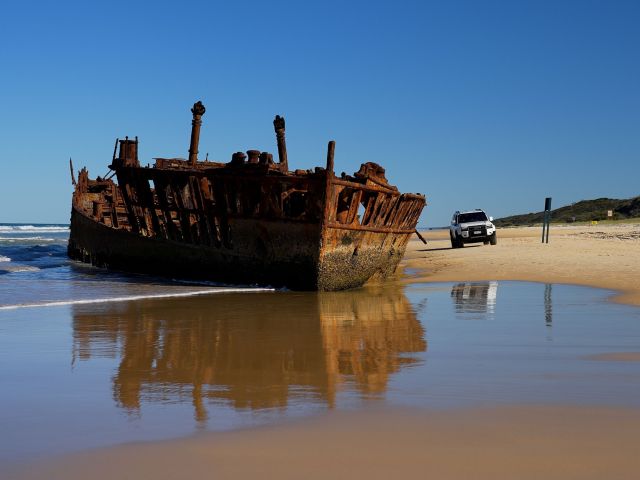Get ready for a deep dive into the top K’gari lakes and swimming spots.
As a country, Australia is in no way short of spectacular places to swim. But when it comes to sheer breadth of choice, K’gari lakes make the island a top contender. With around 40 freshwater lakes, as well as a number of stunning creeks, it would take even the most committed water-lover days to take a dip in them all.
Before you dive into a list of our favourite swimming spots below, don’t forget one of the most important rules about swimming on K’gari. While it’s good to be sun-safe while swimming, pollutants like sunscreen are incredibly damaging to its delicate ecosystem. Instead, grab a long-sleeved rashie, plonk on that hat and monitor the amount of time you spend having fun in the sun.
1. Lake McKenzie/ Boorangoora
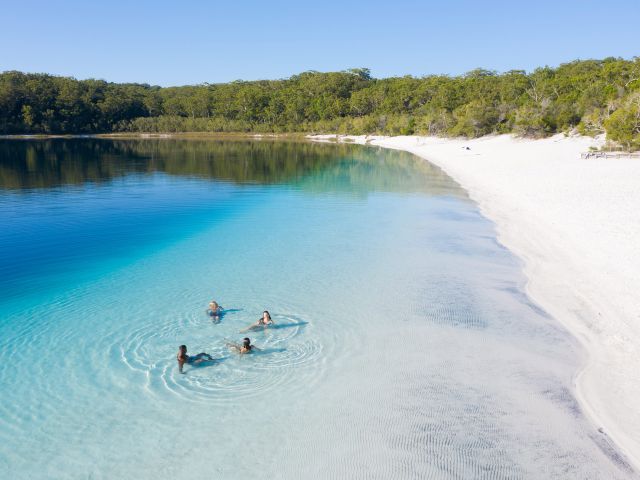
One of the most famous of K’gari lakes, and Australia’s most famous perched lake, is a blue wonder filled with pure rainwater. This, and its startlingly white sand (courtesy of it being 98 per cent silica), makes this coastal dune lake one of the most popular spots to swim on K’gari.
Tips for visiting: Lake McKenzie is undeniably drop-dead gorgeous … but it’s not exactly a well-kept secret. In order to avoid the crowds, the best time to come here is early morning or after 3pm. One of the best ways to get there early is to opt for a spot of camping nearby.
Getting there: Like most of the locations on K’gari, you will likely need a 4WD to reach the lake and park nearby. Alternatively, you could hike to the lake via the Lake McKenzie walk after departing the barge or book a K’gari tour to Lake McKenzie.
2. Orange Creek
Named for its orange-to-tea coloured hue that is caused by fallen leaf tannins, Orange Creek on K’gari is a family-friendly swimming hole.
Tips for visiting: Orange Creek is sandy-bottomed and shallow, making it perfect for a paddle with kids under supervision.
Getting there: Located in the northern part of K’gari, not far from Orchid Beach and the Beach Camping Zone 8, the best 4WD route to reach Orange Creek is by making your way up to Indian Head and Orchid Beach to cross the stream.
3. Champagne Pools
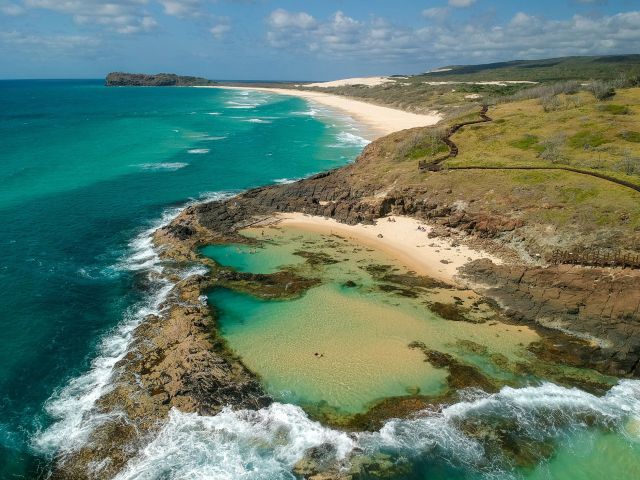
As the name would suggest, these sheltered tidal pools are particularly famous for the pleasant fizzing sensation that happens when waves crash into the water of the pools. Sit back in their blue-green depths to enjoy the refreshing tickling feeling across your skin.
Tips for visiting: While the Champagne Pools are relatively safe, caution should be taken at high tide. For a safer all-around experience, visit at low tide instead. And remember, while it might be tempting to cross the rocks and try your luck in the ocean, don’t. It is not safe. (Skip to the end of this list to find out exactly why.)
Getting there: The pools are located along 75 Mile Beach on the eastern side of the island, between Waddy Point and Indian Head. To get here, drive just over 2km north from Indian Head, before parking in the carpark or right on the beach.
4. Ocean Lake
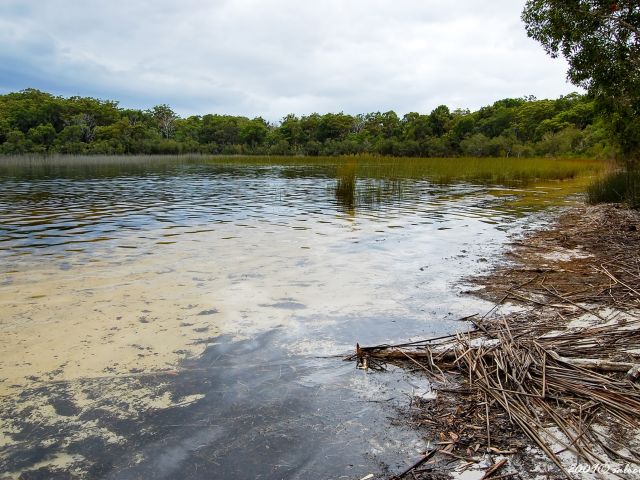
The tea tree-stained waters of Ocean Lake might not have the same aesthetic oomph as the bright aquamarine blues of Lake McKenzie. But the natural oils that are excreted from the surrounding trees have multiple soothing benefits. Expect a bath here to leave you, and your hair and skin, feeling incredibly refreshed.
Tips for visiting: Ocean Lake is a pretty remote location for a swim, so make sure you pack enough food and water and consider pairing it with a trip to the nearby Champagne Pools.
Getting there: Ocean Lake is located in Beach Camping Zone 8, around 5km north of Orchid Beach, on the Eastern Beach scenic drive. From the Champagne Pools carpark, head onto the Waddy Point Bypass and drive just over 10km to the Ocean Lake campsite and the lake beyond. Drivers take note – this drive is only accessible for two hours on either side of low tide, so keep a very close eye on your watch .
5. Lake Boomanjin
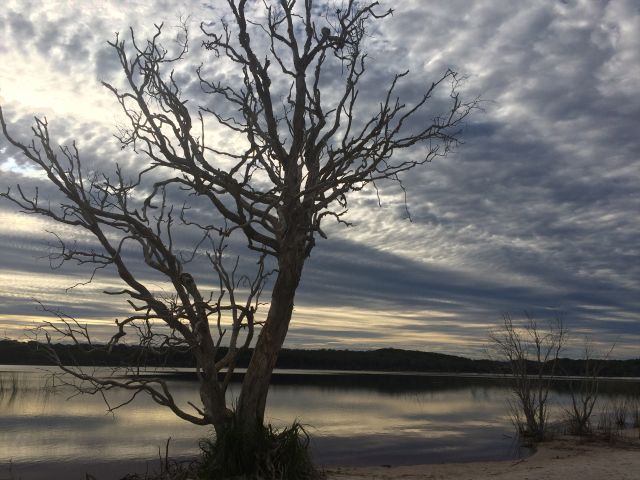
Another perched lake to compete with the ever-popular Lake McKenzie, the secluded Lake Boomanjin is characterised by its silica sand and reddish-brown hue. This is a result of tannins from the nearby trees.
Tips for visiting: You can actually camp at Lake Boomanjin. The campsite has a picnic table, a dingo-deterrent fence and toilet facilities.
Getting there: The lake is located on the Southern Lakes scenic drive and just over 10km north of the eastern beach at Dilli Village.
6. Lake Wabby

The deepest lake on the island is also one of the most picturesque, with striking green water and white sand. See fish dart about in the depths, as you step in there to cool off after finishing the hike needed to get here.
Tips for visiting: While it might be attractive, Lake Wabby is also pretty deep. The walk to get there is also strenuous, and it’s not unusual to see dingoes (known as wongari to the local Indigenous Butchella people). All in all, Lake Wabby is incredible, but not the best swimming spot to visit with kids.
Getting there: You can’t drive up to this lake, and instead, you have to park your 4WD after taking a 10-minute drive north from Eurong along 75 Mile Beach to near One Tree Rocks campsite. From here, you’ll need to walk 45 minutes over soft, sometimes hot, sand dunes to get to Lake Wabby.
7. Lake Allom
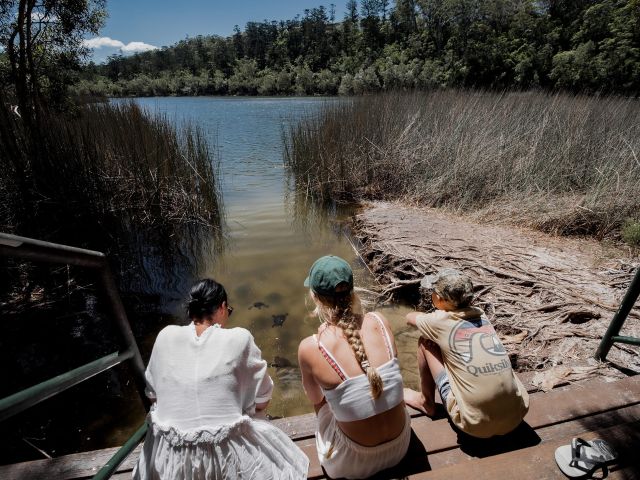
No matter how early you get up to swim in Lake Allom, you’ll find some more ardent locals have beat you to it. We’re talking of course about the resident Krefft’s river turtles. Admire them from a shoreline populated by a rainforest of kauri and hoop pine trees, or head into the waters yourself.
Tips for visiting: There’s a picnic area at Lake Allom , from which it is possible to do the 1.4km Lake Allom circuit walk.
Getting there: You can reach Lake Allom by 4WD via the same track that takes you to the Knifeblade Sanblow lookout, just after Beach Camping Zone 5.
8. Basin Lake
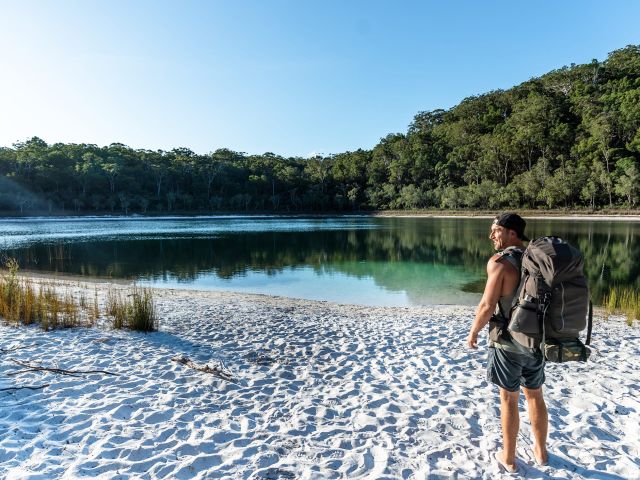
This perched lake is unique in that it is also a window lake, meaning it contains a combination of rain and groundwater. Basin Lake is a little more remote than some of the other lakes, so you may find that you’re able to slip into its peaceful, clean waters with relatively fewer people.
Tips for visiting: Once you tire out from swimming, sunbathe while keeping an eye out for the over 300 species of birds that call this area home.
Getting there: Not too far from Central Station, you can reach Basin Lake by taking the 5.6km return walking track from there, or by taking the inland track with your 4WD.
9. Lake Birrabeen
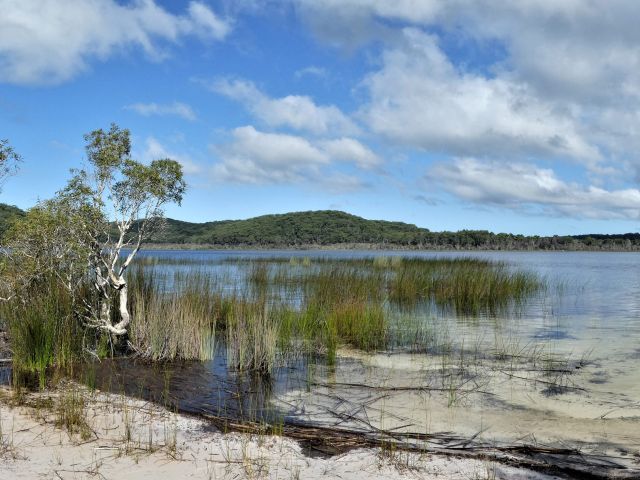
A quieter alternative to Lake McKenzie/Boorangoora, the perched lake called Lake Birrabeen can be found in the south of K’gari. Like its more well-known counterpart, Birrabeen has white sands to lie on and warm waters to swim in.
Tips for visiting: Want to camp at Lake Birrabeen? The nearest campsite can be found at Central Station.
Getting there: Travel to the south side of K’gari by 4WD, and take the Southern Lakes scenic drive through the rainforests of the island to Lake Birrabeen.
Where can I find a map of K’gari’s lakes?
Get around the sometimes poor mobile phone reception on the island, and download this map of the island’s lakes from the Queensland Parks and Forests website before you leave.
Can you swim in the sea at K’gari?
Swimming off the coast of K’gari is not recommended and is extremely dangerous. Reasons for sticking to the above options include the presence in the ocean of strong currents and rips, great white sharks, Irukandji jellyfish, and – on occasion – saltwater crocodiles. There are also no lifeguards on the beaches of K’gari.
While some may recommend the relatively sheltered Platypus Bay near Orchid Beach, there are still dangers to be found here, such as venomous jellyfish. Instead, spend a day at the bay keeping an eye out for migrating humpback whales in winter or getting out the tackle and bait for some fishing.
If you are craving the feel of salt on your skin, the Champagne Pools should make for a delightful fix.

